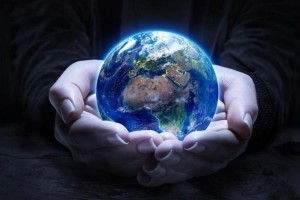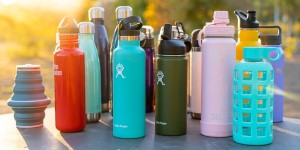|
What does Eco Friendly mean? It means not being harmful to the environment. This focus of this page concerns the usage of Water Bottles, both single-use disposable and reusable bottles.
|

|
As you travel, be conscious of how you can help the environment. There are some simple changes you can make that will help make a big difference to our home...our planet. |
When it comes to purchasing a nice bottle to bring on your travels, there are numerous options available. You will find different sizes, shapes, colors and options, so select something that works for you. You will also find that some bottles are extremely pricy while other may only cost a couple of dollars. A high quality bottle will last for years so it may be worth spending a little more for something you intend to keep and reuse on future trips. Look for something that fits easily into an exterior side pocket of your backpack or can easily be attached to your pack if necessary.
 Remember that your bottle must be empty when going through airport security. Once your exit security, simply fill it up at a public drinking fountain or if you prefer, at a restaurant. Remember that your bottle must be empty when going through airport security. Once your exit security, simply fill it up at a public drinking fountain or if you prefer, at a restaurant.

Throughout our website, you will find various photos of us filling our water bottles at public fountains. Throughout Europe, in many locations such as cities in Italy and Switzerland, you may fill your water bottles and drink directly from public fountains. The fountain water is the same as water from the tap in hotels and restaurants.
When we first began traveling, we would purchase numerous plastic water bottles over the course of our trip. When we finished one, we would discard it and purchase a new one; never giving it much thought. Two people on a two week trip drinking a bottle a day would add up to 28 bottles, more during hot summer months. Now multiply that number times the number of tourists per day per year and that’s a lot of plastic bottles.
In recent years, being more conscious of the environment, we starting purchasing fewer bottles. We would typically buy one bottle after airport security and refill it as needed during the course of our trip. This significantly cut down on the number of bottles we used, 1 or 2 per person for the entire trip. The photo below shows Eddie refilling a plastic bottle at a public water fountain in Zermatt Switzerland. He purchased the bottle after airport security in Denver, Colorado and reused it throughout the entire trip.
|
Public Water Fountain
|
|

|
|
Zermatt Switzerland
|
Recently on the news, we saw that the San Francisco Airport will start banning the sale of plastic water bottles. This is a step in the right direction and more and more airports and other locations will follow suit. We have also seen changes in the usage of plastic straws. Some restaurants no longer provide them, or you have to specifically request them. At the time of this posting, our most recent trip was to England & Scotland in the Spring of 2019. We made the decision to eliminate plastic bottles from our entire trip by purchasing aluminum reusable bottles. This worked extremely well and we had not issues refilling them in our hotel or at restaurants when required. One nice benefit was that the bottles are somewhat insulated, so water stayed colder longer than it would in a typical disposable plastic bottle.
Throughout most of Europe, you will find that it’s completely safe to drink water from the tap, so filling your bottle is never an issue. However, if you are travelling to locations such as India, you should not drink the water and you must be cautious when drinking bottled water. Some locations will reuse bottles by refilling them with tap water and then serve them at your table. Having spent 5 weeks in India, I always had to be sure that I was the one who broke the cap seal on the bottle. If I was served a bottle that did not have a sealed cap, I had to send it back and politely ask for an unopened bottle. On a side note, in India I had to brush my teeth with bottled water and avoid getting water in my mouth while in the shower.
For additional information on drinking water, see our page: Water - Still, Sparkling & Tap.
|